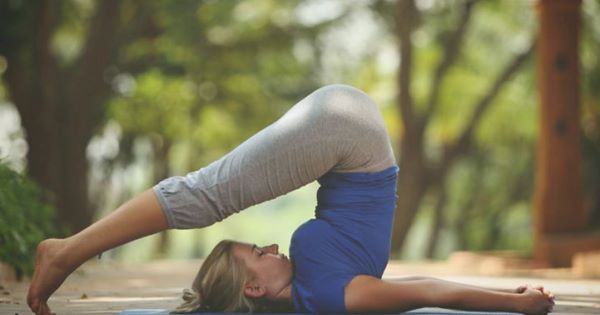Halasana, known in English as the Plow Pose, is a rejuvenating and advanced yoga posture that stretches the spine, shoulders, and neck. This pose is named after the plow, a traditional farming tool used in Indian agriculture, symbolizing cultivation and preparation for growth. Halasana is renowned for its profound benefits in enhancing flexibility, reducing stress, and improving overall well-being.
History
Halasana has its roots in ancient yoga practices and is mentioned in classical yoga texts. The pose has been practiced for centuries for its therapeutic benefits and its ability to promote physical and mental health. It is an integral part of Hatha Yoga and is often included in advanced yoga sequences.
How to Do Halasana
To perform Halasana correctly, follow these steps:
- Starting Position: Lie flat on your back on a yoga mat with your arms resting alongside your body, palms facing down.
- Lift the Legs: Inhale and lift both legs off the floor, keeping them straight. Raise them to a 90-degree angle.
- Engage the Core: Press your palms into the mat and engage your core muscles to support your lower back.
- Raise the Hips: Exhale and lift your hips off the floor, using your hands to support your lower back if needed. Bring your legs over your head.
- Reach the Ground: Slowly lower your legs until your toes touch the floor behind your head. Keep your legs straight and your feet together.
- Position the Arms: Once stable, release your hands from your lower back and extend your arms on the mat, palms facing down.
- Hold the Pose: Hold the pose for 15 to 30 seconds, breathing deeply and steadily. Ensure your neck and shoulders remain relaxed.
- Release the Pose: To come out of the pose, bring your hands back to support your lower back. Slowly and carefully roll your spine back onto the mat, one vertebra at a time, until your legs are back in the starting position.
Health Benefits
Regular practice of Halasana offers numerous health benefits, including:
- Spinal Flexibility: Enhances flexibility and strength in the spine, promoting a healthy back.
- Stimulates Thyroid: Activates the thyroid gland, improving metabolism and hormonal balance.
- Reduces Stress: Calms the mind and reduces stress and fatigue.
- Improves Digestion: Stimulates the digestive organs, aiding in digestion and relieving constipation.
- Enhances Circulation: Improves blood circulation, particularly to the brain and upper body.
Who Should Do Halasana
Halasana is beneficial for individuals who:
- Seek to improve spinal flexibility and strength.
- Want to reduce stress and promote relaxation?
- Aim to improve digestion and relieve digestive issues.
- Desire to enhance blood circulation and metabolic function.
- Are looking for a pose to calm the mind and reduce fatigue?
Also, read: All you need to know about Yoga Pose Uttana Padasana- Raised Leg Pose
Who Should Not Do Halasana
Certain individuals should avoid or take precautions when practicing Halasana:
- People with neck or back injuries should avoid this pose or practice under the guidance of a qualified yoga instructor.
- Individuals with high blood pressure, heart conditions, or glaucoma should avoid this pose.
- Pregnant women should not practice Halasana.
- Those with severe spinal issues or hernias should consult a healthcare provider before attempting this pose.
Precautions to Take
When practicing Halasana, keep these precautions in mind:
- Ensure that your neck and shoulders remain relaxed and not strained.
- Avoid jerky movements when lifting or lowering your legs.
- Practice mindfully and listen to your body to avoid overstretching or strain.
- Use a folded blanket under your shoulders for added support and to protect your neck.
References and Sources
Halasana is a powerful yoga pose that offers numerous benefits for both body and mind. By incorporating this pose into your regular yoga practice, you can improve your overall health and well-being. Always practice mindfully and consult with a yoga instructor if you have any health concerns.





